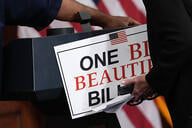You have /5 articles left.
Sign up for a free account or log in.
SEATTLE -- Some universities have started forgoing their ability to issue tax-exempt bonds, long considered a benefit of their nonprofit status. Issuing taxable bonds instead makes sense under market conditions that defy conventional wisdom and allows institutions to avoid additional regulations on tax-exempt bonds, according to officials at an annual conference of college business officers.
Governments and nonprofit entities -- including both public and private nonprofit colleges -- have long been able to borrow money using tax-exempt bonds. The bonds allow lenders to skip paying taxes on the interest they earn. That's an incentive for lenders to lend money cheaply to institutions that serve a public purpose.
Common sense suggests that these tax-exempt bonds would be the best way for colleges to borrow money. But that may not be true in some cases, particularly for 30-year bonds, and business officers may be increasingly open to using taxable bonds.
Since January, at least 11 colleges have issued taxable bonds, according to figures compiled by the New Jersey-based Swap Financial Group. These institutions include well-financed private colleges like the Massachusetts Institute of Technology, Northwestern University and Yale University. Publics, including the University of California, the University of Illinois and the University of Massachusetts system, have also used taxable bonds in the past six months. At least some of the institutions have been using taxable bonds for several years.
Representatives from Swap Financial, the UC system and MIT gave a talk about the advantages of tax-exempt and taxable bonds here on Sunday during the annual meeting of National Association of College and University Business Officers. The session was one of several at the business officers' meeting on the topic of debt, which institutions are increasingly using as some of their other sources of funds shrink.
Lenders give lower interest rates to nonprofit borrowers because the lender won’t be paying taxes on their earnings. For example, a typical lender might pay about 35 percent in taxes on the money it earns from bond payments by a for-profit on a taxable loan. If a for-profit borrower would normally have to pay a 5 percent interest rate, the interest rate for a nonprofit borrower should -- in a perfectly efficient market -- be 35 percent less, making the college's interest rate 3.25 percent versus 5 percent for a for-profit. That would be significant savings for a college taking out a 30-year debt obligation.
But that's not quite how things are working right now, said Peter Shapiro, the managing director of Swap Financial.
Even though logic would dictate that tax-exempt interest rates should be 35 percent lower than taxable interest rates, they are only about 20 percent less for 30-year bonds.
“It does not pass that benefit through to you as borrowers as it hypothetically should,” Shapiro said of the market.
Tax-exempt bonds are also subject to more regulatory scrutiny and restrictions on how the money can be used by borrowing colleges. One of those restrictions could hamper a college’s ability to partner with corporations to use buildings financed with tax-exempt bonds.
Shapiro suggests colleges should seriously consider issuing taxable bonds if the interest rate is less than 0.5 percent higher.
But Allen Marcum, the budget director at MIT, said, “My threshold of pain is a lot higher” -- meaning he's willing to pay even higher taxable interest rates -- simply because of regulations on the use of buildings financed by tax-exempt bonds.
Taxable bonds give the universities a freer hand to spend money than do tax-exempt bonds. They can use the money to fund buildings that house joint ventures with, say, a pharmaceutical company or shift money around for uses that are not anticipated, something that is harder to do because of the regulations on tax-exempt bonds.
Some companies have complained that universities are notoriously hard to work with because of the restrictions on private use that come with tax-exempt bond proceeds.
The increased use of taxable debt by major research universities could change that.
Sandra Kim, an associate vice president for the California system, said it was “more than a full-time endeavor” for the UC system to police private uses of its facilities, which are spread across 10 campuses, five medical centers and a research laboratory.
At MIT, Marcum knows the headaches of private use restrictions. He cited a Wall Street Journal article last month that talked about how one biotech startup’s CEO was using an MIT classroom for his business. The CEO is friends with an MIT faculty member. The article said the CEO at one point asked an MIT student to leave the room because the CEO had booked it. MIT had to make clear that its facilities -- built using tax-exempt bonds -- are "not available for commercial or industrial meetings."
MIT, for instance, is building a 200,000-square-foot building for nanotechnology and will use taxable bond debt.
“We can’t say what that building will be used for 10 years from now,” Marcum said.
Universities that use taxable bonds can also reinvest money they borrow in the markets, which they aren’t supposed to do with tax-exempt bond money.
The ability to get large taxable debt is largely limited to well-heeled institutions with good credit ratings from agencies like Moody’s Investors Services -- though one notable exception may be Touro College. Fitch Ratings gave the institution a BBB- rating.




